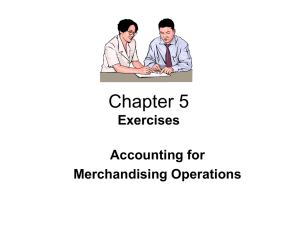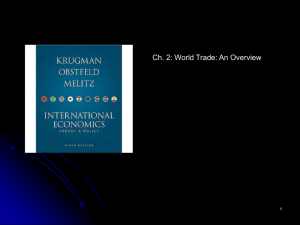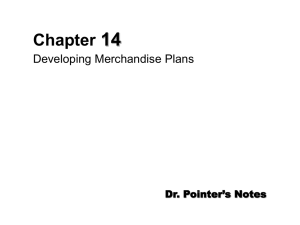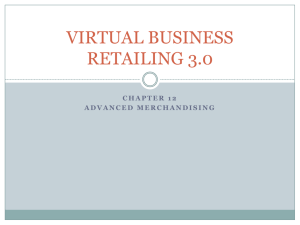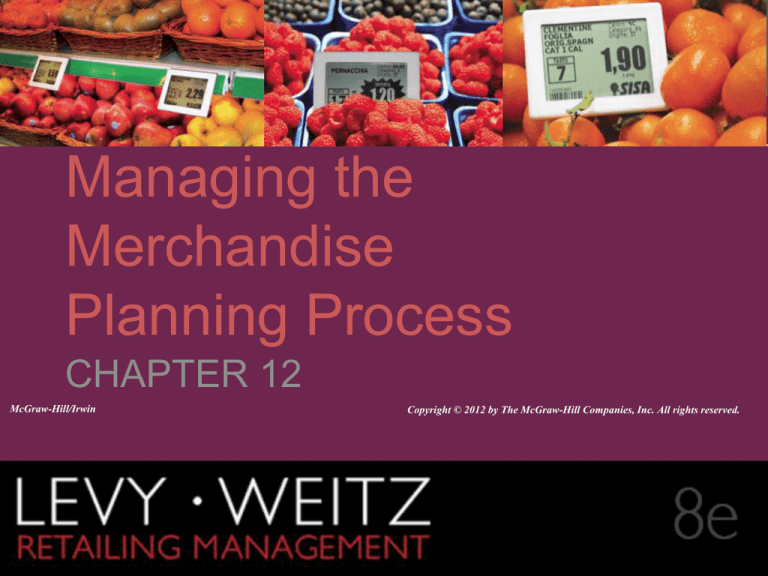
CHAPTER
CHAPTER12
2
1
Managing the
Merchandise
Planning Process
CHAPTER 12
McGraw-Hill/Irwin
Retailing Management 8e
Copyright © 2012 by The McGraw-Hill Companies, Inc. All rights reserved.
© The McGraw-Hill Companies, All rights reserved.
12 -
Merchandise Management
CHAPTER
CHAPTER12
2
1
12 -
Merchandise Management
CHAPTER
CHAPTER12
2
1
• Process by which a retailer offers the correct
quantity of the right merchandise in the right place
at the right time and meets the company’s financial
goals.
• Sense market trends
• Analyze sales data
• Make appropriate adjustments
in prices and inventory levels
c) image100/PunchStock
12 -
Merchandise Management and
Investment Portfolio Management
CHAPTER
CHAPTER12
2
1
• Dollars to invest in inventory
• Invest in “hot” merchandise
• Save a little for opportunities
(open to buy)
• Monitor portfolio of
merchandise (stocks)
• Sell losers (markdowns)
Traders on the stock exchange floor
manage a portfolio of stocks, and retail
buyers manage a portfolio of merchandise inventory. Both
continuously assess the risks associated with their purchase
decisions.
12 -
Buying Organization
CHAPTER
CHAPTER12
2
1
Merchandise Group
Each merchandise group is managed by a general
merchandise manager (GMM),senior VP
Department
Departments are managed by a divisional merchandise
manager (DMM),
Classification
A group of items targeting the same customer type, such
as girls’ sizes 4-6
Category
SKU
Each buyer manages several merchandise categories
(e.g., sportswear, dresses, swimwear, outerwear
categories for girls’ sizes 4-6
The smallest unit available for inventory control
Size, color, style
12 -
Evaluating Merchandise
Management Performance GMROI
CHAPTER
CHAPTER12
2
1
• Merchandise managers have control over
• The merchandise they buy
• The price at which the merchandise is sold
• The cost of the merchandise
• Merchandise managers do not have control over
• Operating expenses
• Human resources
• Real estate
• Supply chain management
• Information systems
• SO HOW ARE MERCHANTS EVALUATED?
12 -
Measuring Sales-to-Stock Ratio
CHAPTER
CHAPTER12
2
1
• Net Sales/Average Inventory at Cost
• Retailers report on an annual basis
• If the sales-to-stock ratio for a three-month season
is 2.3, the annual sales-to-stock ratio will be 9.2
• Estimation of average inventory
• Use information system: averaging the inventory
in stores and distribution centers at the end of
each day
• Divide the sum of the end-of-month (EOM)
inventories for several months by the number of 12 -
Merchandise Planning Process
CHAPTER
CHAPTER12
2
1
12 -
Types of Merchandise Management
Planning Processes
CHAPTER
CHAPTER12
2
1
Two distinct types of merchandise management systems for managing
•Staple (Basic) Merchandise Categories
• Continuous demand over an extended time period
• Limited number of new product introductions
• Hosiery, basic casual apparel
• Easy to forecast demand
• Continuous replenishment
•Fashion Merchandise Categories
• In demand for a relatively short period of time
• Continuous introductions of new products, making existing products
obsolete
• Athletic shoes, laptop computers, women’s apparel
12 -
Merchandise Management Process
CHAPTER
CHAPTER12
2
1
1. Forecasting sales
2. Developing an assortment plan
3. Determining the appropriate inventory level
12 -
Developing a Sales Forecast
CHAPTER
CHAPTER12
2
1
• Understanding the nature of the product life cycle
• Collecting data on sales of product and
comparable products
• Using statistical techniques to project sales
• Work with vendors to coordinate manufacturing
and merchandise delivery with forecasted demand
(CPFR)
12 -
Types of Merchandise
CHAPTER
CHAPTER12
2
1
The McGraw-Hill Companies Inc./Ken Cavanagh Photographer
Fashion Merchandise
Unpredictable Demand
Limited Sales History
Difficult to Forecast Sales
The McGraw-Hill Companies, Inc./Lars A. Niki,
photographer
Staple Merchandise
Predictable Demand
History of Past Sales
Relatively Accurate Forecasts
12 -
Factors Affecting Sales Projections
CHAPTER
CHAPTER12
2
1
Controllable
• Promotions
• Store Locations
• Merchandise Placement
• Cannibalization
Uncontrollable
• Seasonality
• Weather
• Competitive Activity
• Product Availability
• Economic Conditions
12 -
Forecasting
Fashion Merchandise Categories
CHAPTER
CHAPTER12
2
1
Retailers develop
fashion forecasts by
relying on:
• Previous sales data
• Market research
• Fashion and trend
services
• Vendors
12 -
Forecasting
Fashion Merchandise Categories
CHAPTER
CHAPTER12
2
1
• Previous sales data
• Many items in a fashion category are often
similar to items sold in previous years.
• Market research
• Activities range from informal, qualitative
research about trends affecting the category to
more formal experiments and surveys.
12 -
Forecasting
Fashion Merchandise Categories
CHAPTER
CHAPTER12
2
1
• Fashion and trend services
• There are many services that buyers can
subscribe to that forecast the latest fashions,
colors, and styles.
• Vendors
• Vendors have proprietary information about their
marketing plans and tend to be very
knowledgeable about market trends.
12 -
Forecasting
Service Retailers
CHAPTER
CHAPTER12
2
1
• Due to the perishable nature of services, service
retailers face more challenges than fashion
retailers.
• Offerings perishes at the end of the day, not at the
end of the season.
• Must devised approaches for managing demand so
that it meets, but does not exceed capacity.
12 -
Developing an Assortment Plan
CHAPTER
CHAPTER12
2
1
• Assortment plan is a list of the SKUs that a
retailer will offer in a merchandise category and
reflects the variety and assortment that the retailer
plans to offer in a merchandise category
• Variety (breadth) is the number of different
merchandising categories within a store or
department
• Assortment (depth) is the number of SKUs within
a category.
• Product availability defines the percentage of
12 demand for a particular SKU that is satisfied.
Determining Variety and Assortment
CHAPTER
CHAPTER12
2
1
Buyers consider
•Retail strategy
• The number of SKUs to offer in a merchandise category is a strategic
decision
•GMROI of the merchandise mix
•Trade-off between too much versus too little assortment
•Physical characteristics of the store
•Complementary Merchandise
PhotoLink/Getty Images
• Increasing sales by offering more breadth and depth can potentially
reduce inventory turnover and GMROI by stocking more SKUs
12 -
Product Availability
CHAPTER
CHAPTER12
2
1
• The percentage of demand for a particular SKU
that is satisfied
• Level of support or service level
• The backup (buffer) stock in the model stock plan
determine product availability
• The higher product availability, the higher the
amount of backup stock necessary to ensure that
the retailer won’t be out of stock on a particular
SKU when consumers demand it
12 -
Product Availability
CHAPTER
CHAPTER12
2
1
Factors considered to determine the appropriate
level of buffer stock and thus the product availability
for each SKU
•ABC Classification of merchandise (inventory)
• A – higher product availability
• B – medium product availability
• C – lower product availability is acceptable
•Fluctuations in demand
•Lead time for deliver from the vendor
12 •Frequency of store deliveries
Staple Merchandise Planning
CHAPTER
CHAPTER12
2
1
• Buyer Determines:
• Basic Stock or Assortment Plan
• Level of Backup Inventory
• System:
• Monitors Inventory levels
• Automatically reorders when inventory gets
below a specified level
12 -
Inventory Levels for Staple
Merchandise
CHAPTER
CHAPTER12
2
1
• Cycle (base) stock:
• Inventory that goes up
and down due to the
replenishment
process
• Backup (buffer,
safety) stock
• Inventory needed to
avoid stockout
12 -
Basic Stock
CHAPTER
CHAPTER12
2
1
•
Indicates the Desired Inventory Level for Each
SKU
Lost Sale Due
to Stockout
Cost of Carrying
Inventory
12 -
Determining the Level of Backup
Stock
More
Backup
Stocks
Needed
with
CHAPTER
CHAPTER12
2
1
• Higher product availability (service
level) retailer wishes to provide to
customers
• Greater the fluctuation in demand
• Longer lead time from the vendor
• More fluctuations in lead time
• Lower vendor’s Fill rate (% of
complete orders received from a
vendor)
12 -
Fashion Merchandise
Management Systems
CHAPTER
CHAPTER12
2
1
• The system for managing fashion merchandise
categories is typically called a Merchandise Budget
Plan
12 -
Merchandise Budget Plan
CHAPTER
CHAPTER12
2
1
Plan for the financial aspects
of a merchandise category
•Specifies how much money
can be spent each month to
achieve the sales, margin,
inventory turnover, and
GMROI objectives
•Not a complete buying plan-doesn’t indicate what specific
SKUs to buy or in what
quantities
Royalty-Free/CORBIS
12 -
Evaluating the
Merchandise Budget Plan
CHAPTER
CHAPTER12
2
1
• Inventory turnover GMROI, sales forecast are used
for both planning and control
• After the selling season, the actual performance is
compared with the plan
• Why did performance exceed or fall short of the
plan?
• Was the deviation from the plan due to
something under the buyer’s control?
• Did the buyer react quickly to changes in demand
by either purchasing more or having a sale?
12 -
Analyzing
Merchandise Management Performance
CHAPTER
CHAPTER12
2
1
Three types of analyses related to the
monitoring and adjustment step are:
• Sell through analysis
• ABC analysis of assortments
• Multiattribute analysis of vendors
12 -
Sell Through Analysis
Evaluating Merchandise Plan
CHAPTER
CHAPTER12
2
1
• A sell-through analysis compares actual and planned sales
to determine whether more merchandise is needed to
satisfy demand or whether price reductions are required.
12 -
ABC Analysis
CHAPTER
CHAPTER12
2
1
• An ABC analysis identifies the performance of individual
SKUs in the assortment plan.
• Rank - orders merchandise by some performance measure
determine which items:
• should never be out of stock
• should be allowed to be out of stock occasionally
• should be deleted from the stock selection.
•
•
•
•
A items: 5% of SKUs, represent 70% of sales
B items: 10% of SKUs, represent 20% of sales
C items: 65% of SKUs, represent 10% of sales
D items: 20% of SKUs, represent 10% of sales
12 -
Multiattribute Method
for Evaluating Vendors
CHAPTER
CHAPTER12
2
1
The multiattribute method
for evaluating vendors
uses a weighted average
score for each vendor.
The score is based on the
importance of various
issues and the vendor’s
performance on those
issues.
C Squared Studios/Getty Images
12 -
Evaluating Vendors
CHAPTER
CHAPTER12
2
1
• A buyer can evaluate vendors by using the
following five steps:
1. Develop a list of issues to consider in the evaluation (column 1)
2. Importance weights for each issue in column 1 are determined by
the buyer/planner in conjunction with the GMM (column 2)
3. Make judgments about each individual brand’s performance on
each issue (the remaining columns)
4. Develop an overall score by multiplying the importance of each
issue by the performance of each brand or its vendor
5. Determine a vendor’s overall rating, add the products for each
brand for all issues
12 -
Keywords
CHAPTER
CHAPTER12
2
1
• inventory turnover Net sales divided by average retail inventory; used
to evaluate how effectively managers utilize their investment in
inventory.
• gross margin return on investment (GMROI) Gross margin dollars
divided by average (cost) inventory.
• return on assets Net profit after taxes divided by total assets.
• sales-to-stock ratio The net sales divided by average inventory at cost.
It is one component of GMROI and is similar in concept to inventory
turnover except the numerator is expressed at retail (net sales) rather
than at cost (cost of good sold)
• staple merchandise Inventory that has continuous demand by
customers over an extended period of time. Also known as basic
merchandise.
• fashion merchandise Category of merchandise that typically lasts
12 -


